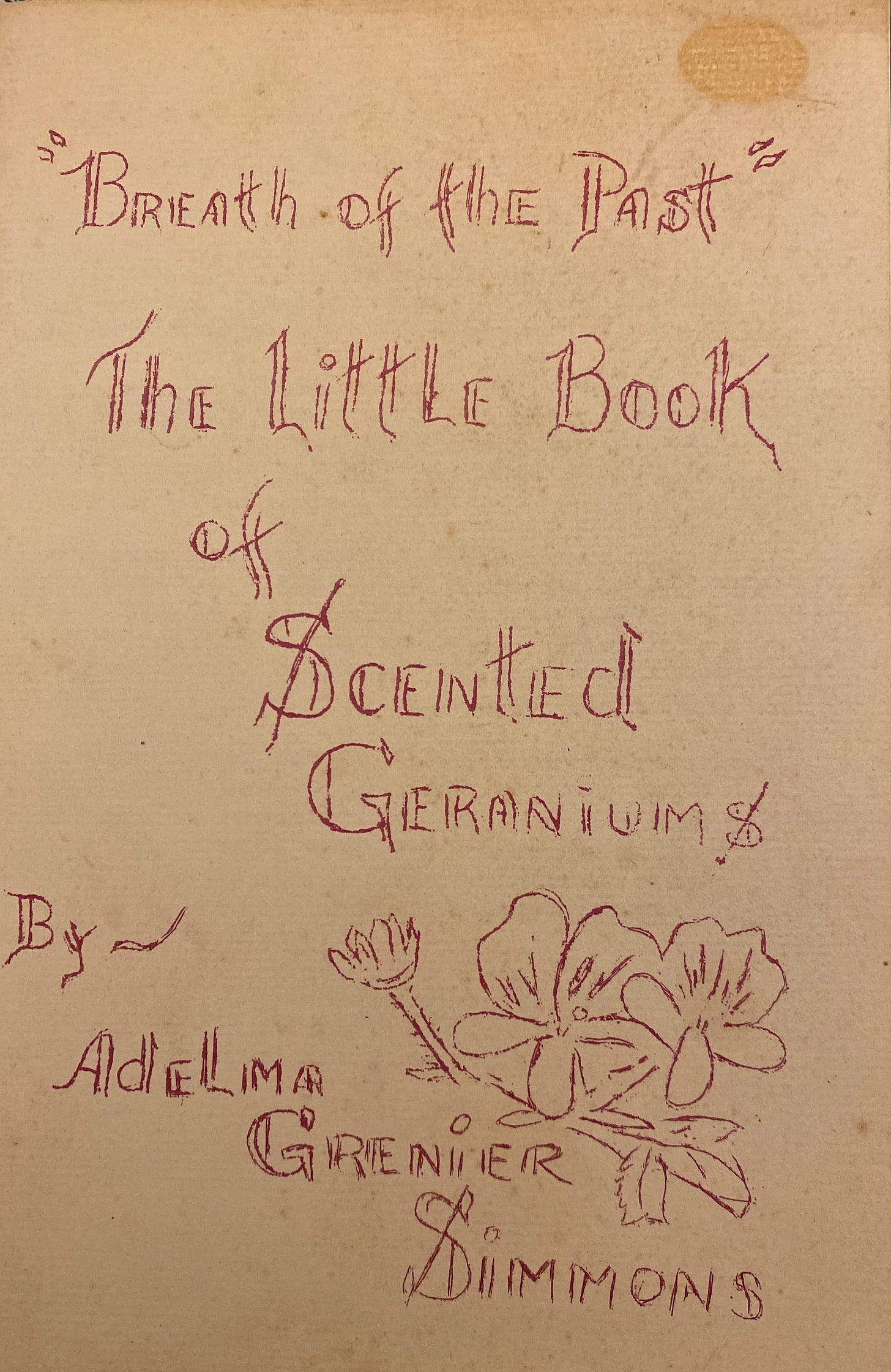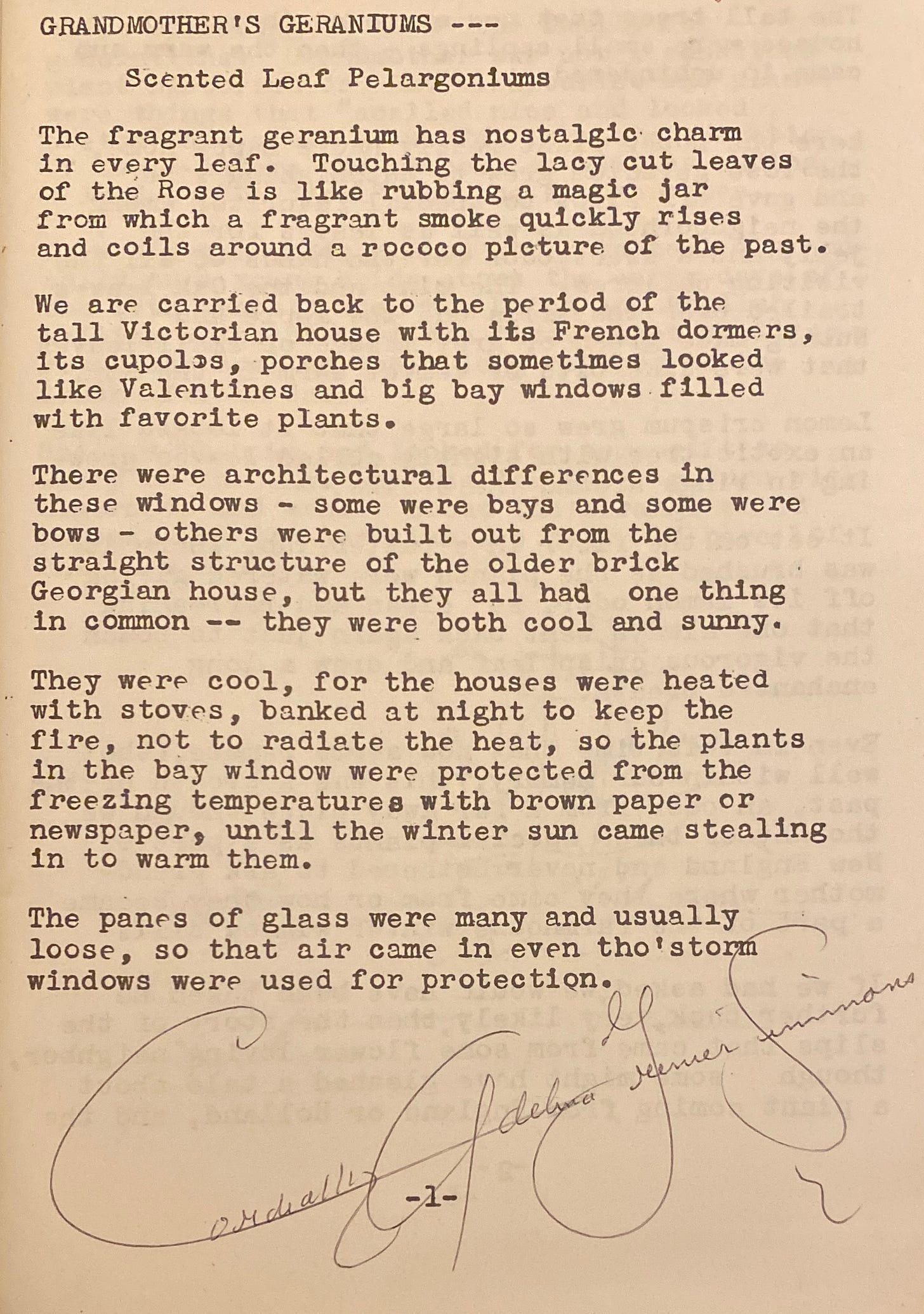When Christmastime rolls around, I head to my shelf of Christmas books and pull out my copy of A Merry Christmas Herbal by Adelma Grenier Simmons (1968).
Some gardeners will now be thinking, “Hmmmm, that lost lady of garden writing sounds familiar.” That could be because when it came to herbs and writing about them, few authors wrote more books than Adelma. According to her obituary in the New York Times, Adelma wrote 35 books and many pamphlets on herbs, including ''Saints in My Garden,'' ''The Witches Brew,'' ''The Gold Wreath Book'' and ''A Merry Christmas Herbal.''
She might also seem familiar because plenty of us are still around who could have met Adelma in person since she passed away just 26 years ago. (More on that later…)
Adelma’s Biography
With a NYT times obituary and several other articles written about her that are now online, I didn’t have to go too deep into Ancestry or newspaper archives to find out that Adelma was born December 16, 1903 and died on December 4, 1997, aged 93. Around 1929, she and her parents bought a failed dairy farm in Connecticut, which they renamed Caprilands because they planned to raise goats. “Capri” is the latin root word for goats.
Apparently the goat farm wasn’t successful, and neither was growing vegetables due to the poor quality of the land. But when Adelma began growing herbs in the 1940s, things took a turn for the better, and Adelma became the herb expert we know of today. (Many herbs grow quite well, and actually prefer, poor soils.)
Along the way, Adelma was married three times. Her first marriage didn’t last long and ended in divorce. Her second marriage to George Simmons lasted until he died in 1965. Her third marriage was to Edward Werner Cook, whom she married in 1993—when she was around 90. Her obituary also says five grandchildren and three great-grandchildren survived her, but none of her children were mentioned.
So I dipped into Ancestry just enough to find a census report showing she had a son, Albert E. Simmons, born around 1939. He may have died in 1974, though I am less certain of that information, but I didn’t find any other records for other children so unless someone corrects me, I think she had just one son.
Though Adelma hoped that Caprilands would continue on after her death as a non-profit called the Caprilands Institute, where others would continue promoting and researching the use of herbs, plants, and flowers, things seem to have gotten a bit messy with probate courts, etc. The farm fell into serious disrepair over the years following her death.
I found an article written in 2022 noting that the original house, which stood on the property for 200 years, had been purchased and was being dismantled and moved to another location in New York.
Adelma’s Herb Business
As mentioned, Adelma wrote 35 books and several pamphlets. Her first book was Herb Gardening in Five Seasons (1963), followed by A Merry Christmas Herbal in 1968. Her last book, Fish and Seafood, was published in 1996. In between, she wrote another 32 books on just about any herb-related topic you can think of.
When she wasn’t writing, Adelma taught classes and hosted groups for lunches at Caprilands for 55 years. She was apparently easy to spot, standing just five feet tall and usually wearing a cape and a custom hat.
She was widely known for her herbal knowledge and was given a lifetime achievement award by the International Herb Society.
I went down a YouTube rabbit hole looking for old videos of Adelma on television. Though I didn’t find her, I found another herbalist, Betsy Williams, who spoke about visiting Adelma during the Christmas season and learning about the long Christmas. Betsy often comments on my blog so it was a lovely surprise to find that video and watch it.
I also did a little more searching through newspaper archives and found an article in The Record (Hackensack, NJ) from January 1969 in which Adelma advises on how she accomplished so much in her business.
“Live each day to the fullest.”
“Never waste a minute.”
“Go about your job with calm persistence.”
”Make your pleasure and work such a happy unity that you never know where one begins and the other ends.”
A Merry Christmas Herbal and Other Books
The only book I have written by Adelma is A Merry Christmas Herbal. I also once had her pamphlet on scented geraniums—signed actually—but sent it off to a friend who loves her scented geraniums. Of course, I took pictures before I sent it.
A Merry Christmas Herbal is a rabbit hole of interesting ways to use herbs through the long Christmas, beginning on St. Barbara’s Day, December 4, and going all the way through Epiphany on January 6th. Chapters include information on various traditions, recipes, craft ideas, and how to grow the herbs mentioned.
A list of herbs used to decorate a manger scene is of particular interest this time of year, and especially this year, the 800th anniversary of the first crèche set up by St. Francis of Assisi in 1223.
The manger herbs included basil, bedstraw, pennyroyal, rosemary, thyme, and the Christmas rose (Helleborus niger).
What she wrote about basil is typical of the interesting information she provided on many of the herbs.
Basil was a favorite charm in Greece and used to banish the mysterious beings called Karkanzari, who made peasant life almost unbearable. These mischievous creatures wandered about through the twelve days of Christmas, supposedly they were the souls who had found no rest in heaven and had returned to disturb the living. To banish such trouble, the priest came to each house with a cross adorned with a sprig of basil. He dipped this in holy water and sprinkled and blessed each room and the environs of the house. Thus the Karkanzari disappeared.
About bedstraw she wrote:
Bedstraw once blossomed white and scentless, but on the holy night the flowers turned to purest gold and a heavenly fragrance filled every minute blossom. Thus bedstraw became one of the most revered plants, too sacred for the touch of devils; after Christmas festivities, it was scattered over the field to bless and increase crops. It was also spread in stalls to protect animals from disease, and on Christmas Eve heaped on the floor for the family to sleep upon.
The bedstraw she refers to is Galium serum, once called Our Lady’s bedstraw, but it also now goes by the common name, yellow bedstraw. Adelma noted it was a good ground cover, choking out all other plants. Today, you’ll find it, unfortunately, on invasive plant lists. The Missouri Botanical Garden suggests it not be planted in the Midwest.
But that’s sometimes how it goes with older gardening books. Plant information is sometimes outdated, not out of ignorance, but they just didn’t know, especially about invasive plants.
Regardless, for the herbal lore, recipes, and craft ideas, Adelma’s books and pamphlets are worth seeking out and adding to your library of gardening books. Good used copies are generally available.
And even though there are people still living who once met her and remember her, many have forgotten her or didn’t know about her, making her a nice addition to the ever-growing list of Lost Ladies of Garden Writing.








